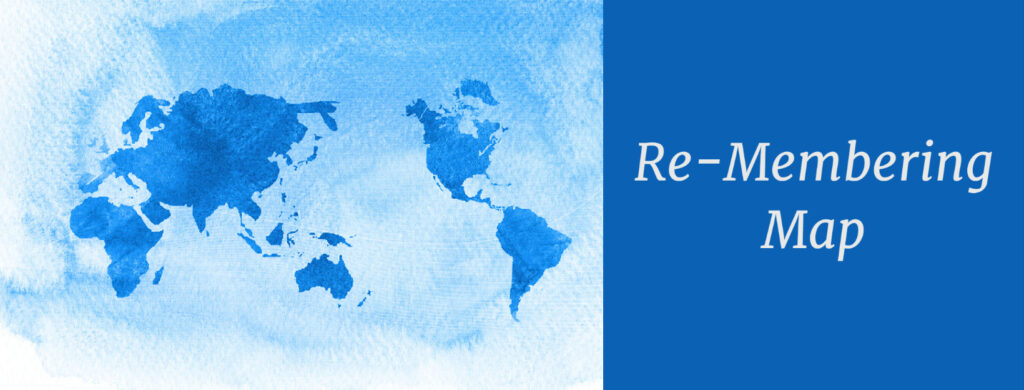Re-Membering Map

Perhaps, whilst you’re inquiring into actions and meaning from the past, the interviewee identifies a significant relationship that has been lost. This is likely to be with a relative or friend but could equally be a pet or even a fictional character.
Using the Re-Membering Map, there’s an option for the rich development of this relationship that might provide future support and contribute to feeling less alone and being more joined or in solidarity with others. It’s not wrong to divert from one map to use another!
Chapter 3 in the book describes and charts the four areas of inquiry. Frequently those new to re-membering can baulk at questions in the last level or two as they can seem difficult to respond to – but without going the whole way up this map you risk characterising the interviewee as a passive recipient of the evoked figure’s care and skills rather than someone who made reciprocal contributions to the other person too.
Have a look at the video with Karl – you may notice how at times the conversation seemed to falter but we found a way back. What do you think about the practices here? Let me know! I’m looking forward to any transcripts of course!
If the interviewee seems unable to respond to these later questions try these things:
- Go back and ask further questions at the next lower level. This can extend the person’s platform of knowledge and make it less of a stretch to reach an answer. Then return to the original question.
- Do an editorial – using the contemporaneous notes you’ve been taking (you have, haven’t you?) remind the interviewee of the things they’ve already said that stood out to you. This positions them as an observer to their own life, a good vantage point to appreciate more fully the importance of this relationship. Talk slowly so they can savour this new position. Remember to use their words. Avoid paraphrasing unless you wish to imply that you know better than they do what the correct words are to describe their life!
- Don’t assume that an “I don’t know” means “I can’t know”. Re-phrase the question and give them a little thinking time.
Exercise
An exercise for an interviewer and interviewee.
Begin by identifying a figure from the interviewee’s life, real or imaginary, whose influence was positive.
- Enquiring about what the re-membered figure contributed to the person’s life:
Tell me about some of the things you did together?
Tell me about some of the ways this figure contributed to your life?
What kind of difference do you think this connection has made to your life? - Enquiring how this figure influenced the person’s sense of who they are and what their life is about:
What do you think this figure might have appreciated about you?
What did this figure recognise in you that others might have missed?
Can you say a bit more about what this figure brought to your life?
If you could see yourself through this figure’s eyes what might you appreciate or value about yourself? - Enquiring what the person might have contributed into the figure’s life:
What might you have done to take in or receive the figure’s interest in you?
What did you do to join in with their life or interests?
How might these things have made a contribution to the figure’s life?
What might have been a little different about their life on account of this connection with you?
If the re-membered figure wasn’t human: If this figure could have responded to your interest (with the kind of character they had), what might they have done?
- Enquiring into ways this connection influenced the figures sense of who they are or what’s important in life:
What might have been made possible for the figure on account of knowing you?
What would you guess your contribution to their life might have had them appreciating about themself?
What might this connection have reinforced or affirmed about what the figure held precious?
If they had known how important this connection was for you what might it have been like for them?
If the re-membered figure wasn’t human: What might your valuing of this connection have meant for the author/character/kind of figure this was?
